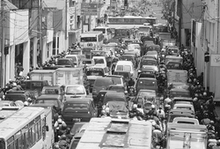Who is Planner? A Challenge for Planning Profession in Indonesia
 Hours before sunrise in early January 2005 in Jakarta, originally uploaded by Sebastian Leonard.
Hours before sunrise in early January 2005 in Jakarta, originally uploaded by Sebastian Leonard.- Planners formulate policies to meet the needs of communities including social, economic, and physical needs and they develop the strategies to make these plans work
- Planners develop plans for land use patterns, housing needs, parks and recreation facilities, transportation systems, economic development, environmental protection and other aspects of the future
- Planners work with the public to develop a vision of the future and to build on that vision
- Planners often function as mediator among conflicting community interests; they may also become facilititors using their professional judgment to help identify the best resolutions to the conflict
- Planners advise public officials and citizens in shaping the future
- Planners design and manage the planning process and attract public to involve in the process.
Can someone with the only skill of simple math for elementary school student do planner's job as mentioned above? Of course not! We need planning education to prepare a to-be-planner with skills that can not be delivered in only a two-day planning class.
In 1997, ACSP assigned the strategic marketing committee to identify the core of planning identity that clearly distinguishes planning from other disciplines. The committee reveals six themes that anchor planning's identity (Myers, 1997: 223-224):
- A focus on improvement of human settlements with:
• emphasis on understanding cities, suburbs, small places, and regions, including processes of physical development and their changing social and economic characteristics; and
• emphasis on making places better serve the needs of people, including solving perceived urban problems. - A focus on interconnections among distinct community facets, incorporating:
• linkages among physical, economic, natural, and social dimensions;
• linkages among sectors, e.g. transportation and land use, housing and economic development, etc.; and
• linkages between public and private enterprises. - A focus on the future and pathways of change over time, encompassing:
• affirmation of community goals and aspirations;
• forecasting probable or feasible paths;
• developing plans to achieve desired futures; and
• understanding historical momentum shaping the present and future. - A focus on identification of the diversity of needs and distributional consequences in human settlements, guided by:
• concern for public well-being;
• monitoring changing population;
• targeting needs of all segments in the population; and
• developing rationales for equitable distribution of community benefits. - A focus on open participation in decision making, including:
• citizen participation;
• stakeholder representation;
• negotiation and mutual compromise among competing interests;
• dispute resolution;
• communication of technical facts in lay terms; and
• recognizing value-centrism embedded in analysis and prescription. - A focus on linking knowledge and collective action, recognizing that:
• planning bridges academic knowledge and professional practice;
• information flows across the bridge both ways, linking the university to the “real world”;
• planning practice is enhanced by infusion of humanities, social science, and technical knowledge; and
• academic knowledge is enhanced by confrontation with experience in practice.
The above planning's identities also reveal how planners differ from other professions. Planner with these identities clearly plays seminal role in shaping the future of human settlements. The skill of projecting the future facility needs or land use is only one of many other skills that a planner is supposed to have. Not only is planners a projector -those who project the future needs- but also is an analyst, a spokesperson, a public advisor, a consensus builder or a collaborator.
We should not bother with the fact that many planners project the future needs by using simple math. A more sophisticated projection with complicated formulas can not guarantee that the projection will result in better plan. Planning as a systematic attempt and actions in the public domain to shape the future is best implemented when all stakeholders are involved. The planning practice in the 21st century is facing greater challenges than that in the 20th century. Some of the challenges are the complexity of the problems and the elusiveness of solutions to those problems. A better way of shaping the future of the community is no longer primarily based on the sense of order, comprehensibility, predictability and rationality that prevailed in the modernist era. Projection of future needs as a technical tool of predictability and rationality only prevailed in the 20th century.
The postmodernist era in the 21st century requires more communicative aspects of planning practice. Innes (1997) identifies the post modern era that is characterized by distrust of government and experts. Recent planning practice requires planners to more actively communicate information and ideas to the many people and stakeholders with whom they interact and receive information and ideas in return. A sophisticated projection method does not really matter in the postmodernist era. What matters is making connections among interests, public agencies, and profession and disciplines, between public and private sector and between government and the public. These are the skills that a planner needs to have to face greater challenges in the 21st century.
References:
- Innes, J. (1997). The planners’ century. Journal of Planning Education and Research 16(3): 227-228
- Myers, D. (1997). Anchor points for planning’s identification. Journal of Planning Education and Research 16(3): 223-224.




1 comment:
The Global Planners network is assessing the existing global planning capacity in terms of legal competences, professional skills, inclusive processes, and civic leadership and vision. Have you seen the web based self-diagnostic assessment of your personal experience. It can be accessed through this link: http://tinyurl.com/2gbffk. You should fill it in.
Post a Comment